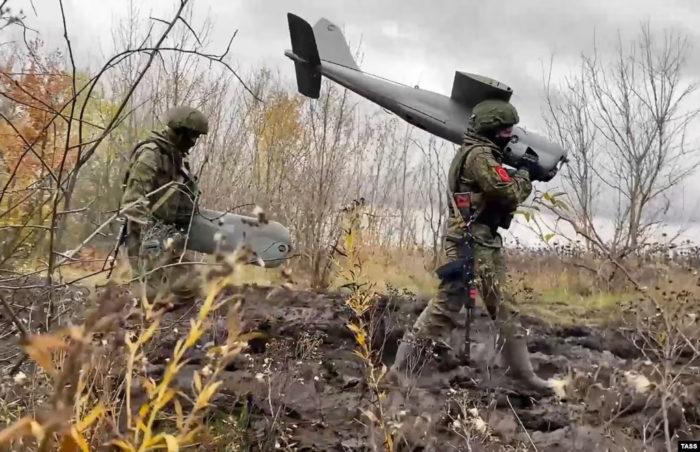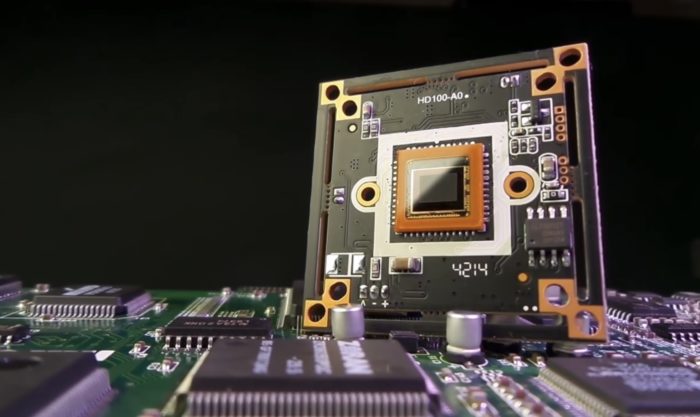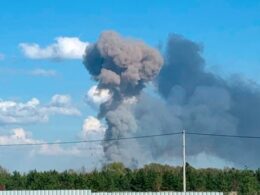According to open data and official statements, Ukraine’s state project, Army of Drones, domestic industry, and volunteers now provide hundreds of drones to the army daily, which means thousands every month and dozens if not hundreds of thousands per year.
While precise data is classified, the variety of drones includes small reconnaissance FPV drones, kamikaze drones, and so-called heavy drone bombers, mainly Ukrainian-produced, such as R-18 or the formidable Baba Yaga:
Domestic drone production has started gradually replacing drone imports, but this is still not enough, given the scope and intensity of warfare, while by some items, Ukrainian production is far behind Russian.
Drone suppliers: from volunteers to the Army of Drones
Early in the war, many independent volunteer initiatives supplied drones for the Ukrainian army, including the famed Come Back Alive, Razom for Ukraine, or Madiar Birds, who collected and continue collecting millions in donations from ordinary Ukrainians.
It took time for the state to adapt to new drone warfare. In 2023, the share of state efforts in drone supplies has gradually increased and, it seems, has already surpassed volunteer supplies. This change signifies a more stable provision of crucial equipment for the Ukrainian army, with about 150 Ukrainian companies underpinning the effort by producing drones.
Given the scope of the war, all this work done is still far from meeting all army needs. To make available resources more efficient, Ukraine's General Staff created a special drone company in every Ukrainian brigade – an entirely new and autonomous type of troops. The Army of Drones is a state project to supply drones to these units.
The Army of Drones was launched in July 2022 by Ukraine’s Ministry of Digital Transformations, the Ministry of Defense, and the General Staff of the Armed Forces of Ukraine. It was first announced as a fundraising campaign within the fundraising platform UNITED24 but quickly expanded beyond it and was supported by the state budget.
At least UAH 48 billion ($1.3 billion) will be allocated from Ukraine's budget for the Army of Drones in 2024 to purchase both domestically produced and foreign drones. This is an increase from UAH 30 billion ($0.8 billion) in 2023. The new law adopted in March 2023 transformed the Army of Drones into a huge centralized state program.
Ukraine's "Army of drones" hands over 1,700 drones to the frontline
— Euromaidan Press (@EuromaidanPress) September 28, 2023
The new batch includes surveillance and strike drones produced in Ukraine and other countries, such as Leleka, R-18 bomber, Penguin, and more. https://t.co/3XClrFqS8H pic.twitter.com/SHJ2kZDqD1
While the state has increased its drone purchases and supplies many times, the largest volunteer initiatives also maintain high volumes and even conduct joint projects with the state.
For example, in the latest case of cooperation, the first 3,000 of the planned 10,000 FPV drones were already supplied to the front within the campaign “Unity.” This was the joint fundraising campaign of United24, Come Back Alive, and Ukrainian bank Monobank. Each of the 3,000 drones was equipped with explosives of Ukrainian production thanks to UAH 235 million ($6.4 million) donated by ordinary Ukrainians.

Ukrainian manufacturers and models
Only several Ukrainian private firms used to produce reconnaissance UAVs before the war, while none of the state companies did so. Ukrainian-made attack/kamikaze drones were also almost non-existent. The situation took a sharp turn since 2022, with hundreds of manufacturers emerging and dozens receiving state contracts.
As of November 2023, within the framework of the Army of Drones, 40 Ukrainian-made drones had permission for combat use and were already receiving state contracts, said Minister of Digital Transformations Mykhailo Fedorov.
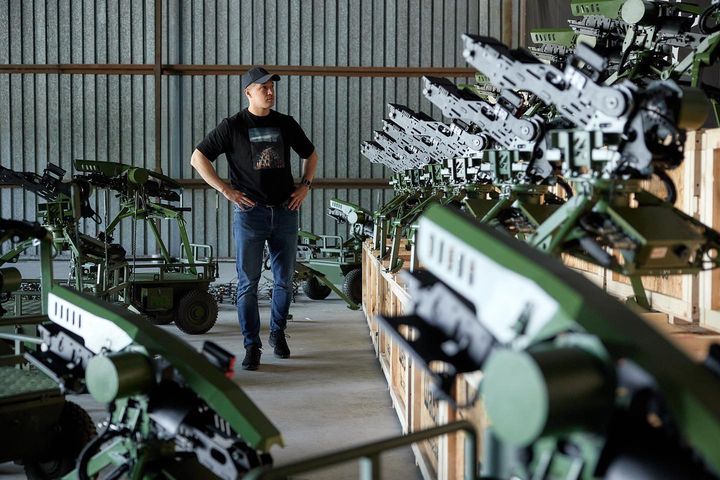
While before the full-scale invasion, Ukraine did not have a single model of attack drones, as of November 2023, seven manufacturers have already received contracts to supply more than 10,000 such UAVs.
One of the best examples was the R-18 octocopter bomber. Developed by Ukrainian NGO Aerorozvidka, it is equipped with a thermal imager, RKG-3 anti-tank grenades, or RKG-1600 bombs and can fly up to 13 km when carrying explosives.
Another example is Ukraine’s so-called Baba Yaga bomber, named after a witch in Slavic folklore who lives in swamps. This large 6-rotor drone is used to bomb Russian positions. It is hard for Russians to counter it by electronic warfare. This drone can fly in an entirely autonomous mode, bomb at the predetermined coordinates and return, or also operate in manual mode. The Baba Yaga typically drops mortar mines, grenades, or specifically designed explosives.
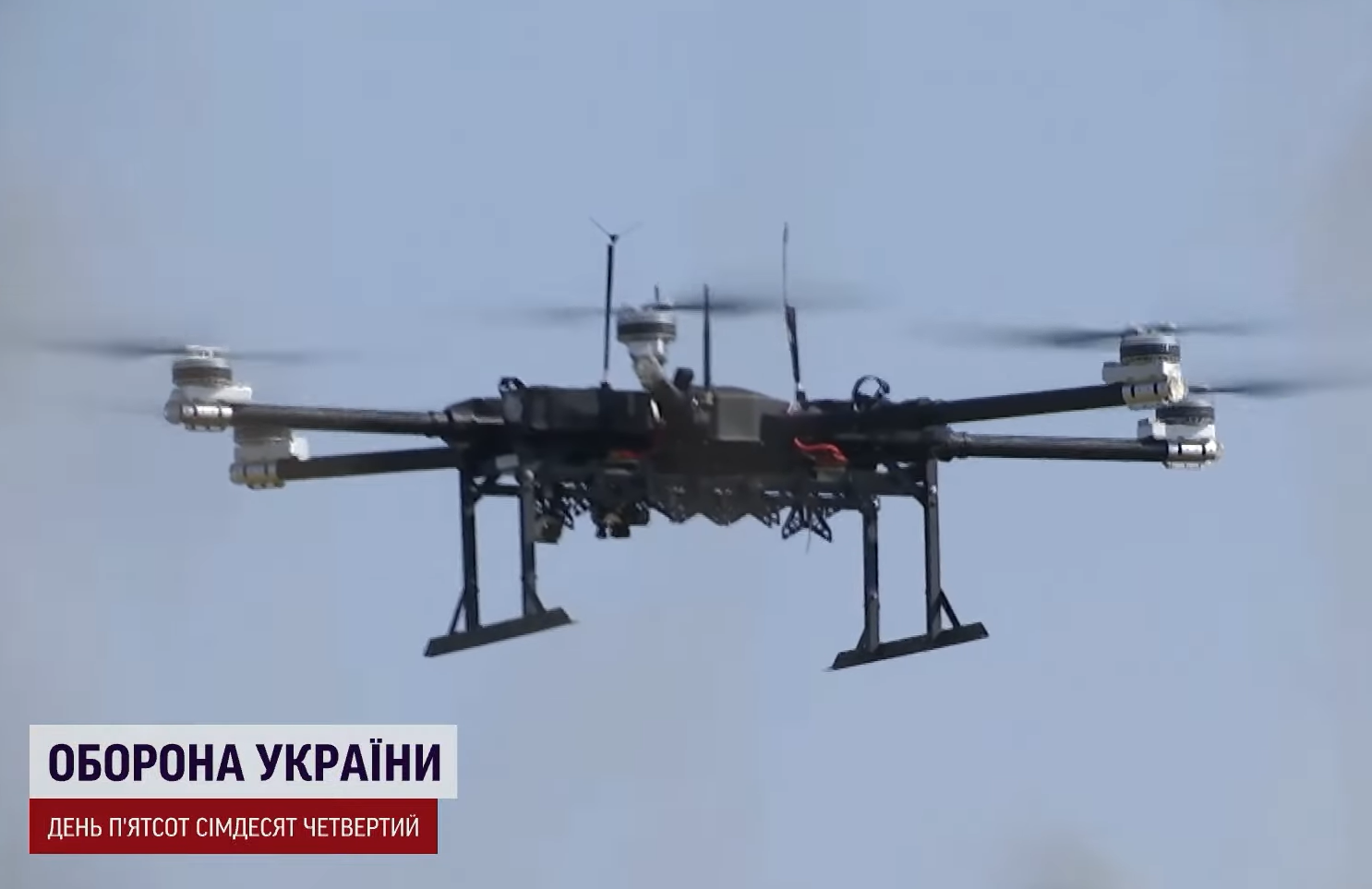
There are more similar models capable of carrying nearly 20 kilograms of explosives and numerous models of kamikaze drones.
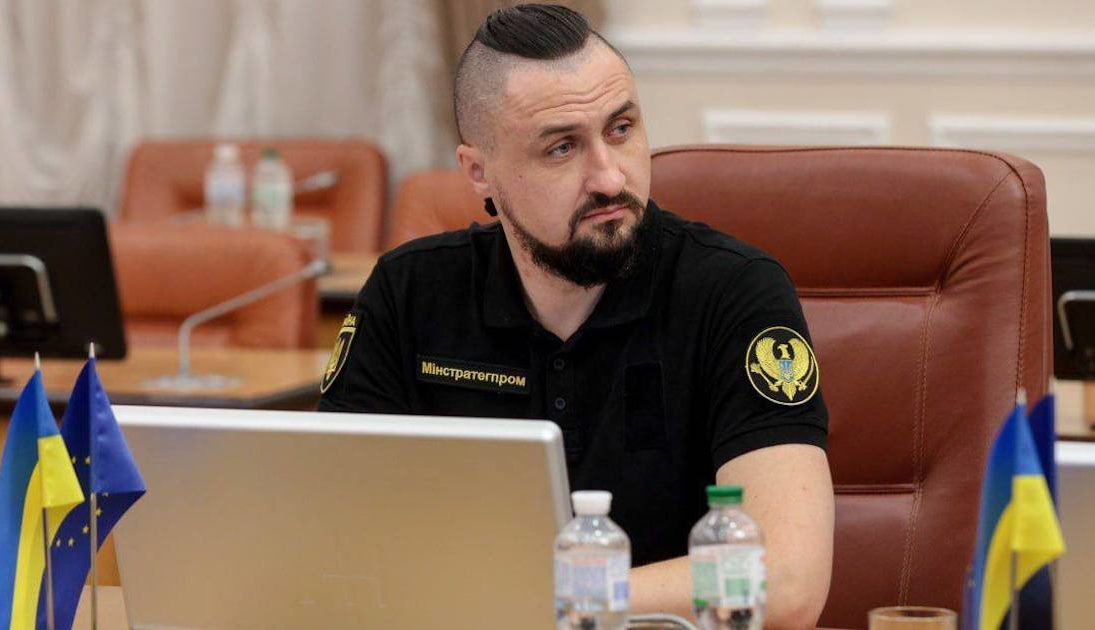
Beyond this, Ukrainian manufacturers have also started producing domestic FPV drones. The vulnerability of these drones' production depends on some Chinese components, but still, this is already a huge step toward autonomy of drone production.
"Tens of thousands" of drones per month will be produced in Ukraine at the end of 2023. As of the end of October, the production volume was several thousand, said Ukraine’s Minister of Strategic Industries Oleksandr Kamyshin.
Ukraine’s Minister of Digital Transformations, Mykhailo Fedorov, provided more details on the TV air on 21 September 2021, saying that, in total, about 200 manufacturers of drones already work in Ukraine. He said that new companies producing UAVs appear every month.
"We have a separate Brave1 project that provides grants for the start of such companies, plus venture capital funds are emerging that provide financing to such startups," the minister said.
He also noted that information about opening new factories is closed to the general public. Still, he assured that the capacity of domestic production in this area is growing.
"We already have assembly line production of thousands of units of such equipment, there are even tens of thousands in a certain category. We simply cannot announce such things loudly," he added.
Judging by photos, it is most likely that the volume of “tens of thousands” applies to small Ukrainian FPV drones, “Shrike,” also used as kamikaze drones. For example, on 28 October 2023, the Army of Drones supplied 1,500 Shrike drones to Ukrainian troops only in the Donetsk direction.
“We are handing over a new batch of Ukrainian-made ‘birds’. These babies were bought with the state program Army of Drones funds. Each drone costs only a few hundred dollars, but the results of their work are impressive,” the Army of Drones commented.
There are also various models of Ukrainian-made reconnaissance drones. Among the most known are the Leleka-100, commissioned to the Armed Forces of Ukraine in 2021, and the Shark UAV supplied since 2022. Both drones were developed by Ukraine’s company Ukrspecsystems.
The Shark was designed during the invasion to correct long-range artillery fire, including HIMARS. The first Sharks were already supplied with the help of costs from the Ukrainian military charity Come Back Alive. Capable of over two hours of flight, the Shark drone maintains communications across distances of 60 kilometers.

Due to a high number of companies and high competition in the sector, larger and more efficient manufacturers absorb smaller ones, and this is good for the supplies, said General Serhiy Baranov, head of the Main Directorate of Missile Forces, Artillery and Unmanned Systems of the General Staff of Ukraine.
"It improves the situation when we go from several different types of drones to five, but the most effective types, which the manufacturer will be able to produce in large quantities to meet the needs of the Armed Forces. It also convenient for people who use and operate them, it will be much easier. Components, spare parts, personnel training on the same type of weapons — it is much easier," he commented.

State companies also started manufacturing drones
At first, state manufacturers were far behind private companies in terms of drone production. In 2022, the Ukrainian Defense Industry, a huge state-controlled association of nearly 100 defense companies, didn’t produce drones, for which it was sharply criticized.
In June 2023, Herman Smetanin, a promising 31-year-old Ukrainian engineer and former director of a defense tank factory, was appointed the new head of the Ukrainian Defense Industry following other reshuffles in Ukraine’s Defense Ministry and Ministry of Strategic Industries.
In his interview in September 2023, Smetanin said that the Ukrainian Defense Industry had already launched manufacturing of the first three drone models in cooperation with Ukrainian private developers. It was the scaling up of FPV drone production.
"FPV drones are in great demand now. We help private firms scale their developments. We have signed license agreements with three large companies to manufacture their models. We have people, premises, components are delivered to us and we manufacture. We help scale developments to anyone who appeals to us," said Smetanin.
Trending Now
Besides FPV drones, the state defense association has also started manufacturing several models of long-range kamikaze drones in cooperation with Ukrainian private companies. Some of the models are reportedly similar to Iranian Shaheds, while others are claimed to be even more powerful. The drones have already hit their first targets in Russia at a distance of about 1000 km, Smetanin said, refusing to disclose more details.
According to Russian media, new yet unknown drones were shot down near Russian Tula on 26 November 2023. They were visually similar to Shaheds.
Drones purchased abroad remain an important part of supplies
According to Ukraine’s Minister of Strategic Industries, Oleksandr Kamyshin, Ukraine is increasing the production of drones faster than the production of conventional military weapons and ammunition. Still, like with artillery or ammunition production, the supplies from abroad, though decreasing by share, remain substantial.
Ukraine buys 60% of the total production volume of Chinese Mavic drones, excluding other UAV purchases, Prime Minister of Ukraine Denys Shmyhal stated during the Kyiv International Economic Forum. The minister most likely referred to both state and volunteer-purchased drones, according to the data of the customs service.
"This year, we have allocated an additional UAH 40 billion to purchase drones. These are drones of Ukrainian and foreign production. Ukraine buys 60% of the entire world production of Mavic," Shmyhal said.
The state simplified import procedures to enhance the availability of components and drones
On 10 October 2023, the Cabinet of Ministers simplified importing raw materials to produce ammunition and combat parts of UAVs. This step is expected to increase further the production of drones.
Other bureaucracy simplifications included the cancellation of VAT tax on the import of drones and their components from abroad and the introduction of a simplified procedure for obtaining permission to operate UAVs by the military.
According to Fedorov, this change reduced the time to accept new drones into service from months to days or, at most, weeks. Thanks to this, 40 models were officially accepted as of November 2023, compared to 7 at the end of 2022.
Centralized training and organization of troops were implemented
The Army of Drones has also organized 26 UAV operator training centers, established a separate test ground for new UAVs, and trained over 10,000 drone operators.
As a result, the drone army became a separate type of troop since each brigade received its separate strike drone company supplied with various models of drones.
In addition, with the National Guard and the Security Service of Ukraine, the Army of Drones has launched several special units that perform special missions using drones. This likely includes another formidable project of Sea Drones, which already proved successful, sinking several Russian warships.
How to measure the effectiveness of the Army of Drones
The Army of Drones claims it is now responsible for nearly 30% of Russian losses of equipment in Ukraine, which would make drones nearly comparable to artillery by the scope of destruction. While artillery remains the main Ukrainian firepower and the availability of shells the main factor determining the battlefield, the drone statistics are also likely close to the truth. Some issues with this data should be noted, though.
Thus, the Army of Drones releases weekly updates showing how much Russian equipment was successfully “destroyed/damaged.” The Army of Drones says each successful drone hit is confirmed by video. However, presumably, not all the hit equipment was destroyed immediately. It can be damaged and still towed for repairs.
Nonetheless, even considering this caveat, the reported results of the Army of Drones look impressive. The question of how much Russian equipment hit by drones should be counted as destroyed, not damaged, remains open, but the vast number of released videos of drone strikes in the Ukraine war proves the overall crucial impact of drones on the battlefield.
Comparing the data of the Army of Drones with daily reports of Ukraine’s General Staff, we come to the number of nearly 30% of total Russian losses being caused by drones. Of course, data of General Staff should be taken with the same caveat – that part of the equipment that was damaged and therefore “lost” could still be repaired by Russians later. Still, the Oryx OSINT project has visually confirmed nearly half of the Russian losses declared by Ukraine’s General Staff. Oryx confirmed most of the destroyed or captured equipment, which, for obvious reasons, was filmed more often than the damaged specimens.
According to these reports by the Army of Drones and Ukraine’s General Staff, in October, for example, the Army of Drones “destroyed/damaged”:
- 208 Tanks or 40% of total losses
- 272 APVs or 33% of total losses
- 421 pieces of artillery or 53% of total losses
- 10 MLRS or 20% of total losses
- Seven air defense systems or 28% of total losses
- 338 other vehicles and special equipment, or 40% of total losses
Lack of transparency of the state service purchasing drones sparked criticism
The weak side of the project is the lack of transparency over the state money spent. While reports of the results of fundraising campaigns are usually backed up with photos and price calculations, this is not the case with state procurements. Moreover, critics say the State Special Communications Service of Ukraine (SSCSU), which operates state funds to purchase drones, is not the institution designed for such large-scale purchases. Instead, Ukraine’s Ministry of Defense should buy the drones.
A new wave of criticism was raised on 20 November 2023, when Ukraine’s National Anti-Corruption Bureau (NABU) charged the former head of SSCSU with corruption, saying he had over UAH 100 million ($2.7 million) of costs of unconfirmed income, while his salary was only UAH 4 million per year ($100,000). NABU suspected Yuriy Shchyhol and his deputy of embezzling state funds of over $1.8 million while procuring tools intended for the system of protected data registers in 2020-2022.
The High Anti-Corruption Court of Ukraine ordered the arrest of suspected Shchyhol with an alternative of a bail of UAH 25 million for the time of investigation and court hearings, which was paid. While court hearings continue, Shchyhol’s guilt, if any, still has to be proved.
The scandal has exacerbated the question of why SSCSU and not the Ministry of Defense purchases drones.
Immediately after NABU issued suspicion against Shchyhol, he was excluded from Ukraine’s Commander-in-Chief's Office, which gathers regularly to make complex defense decisions. Instead, Ukraine’s Minister of Digital Transformations, Mykhailo Fedorov, the main promoter of the Army of Drones, was included in the Office.
Drone production efficiency crucial to achieving military superiority over Russia
As soon as every new drone model is used on the frontline, Russian engineers analyze it and begin creating a countermeasure. At the same time, they are developing their drones for which Ukrainian specialists are creating countermeasures. This is the constant process of technological development and competition, says Serhiy Ristenko, a Ukrainian drone operator testing new models.
For example, recently, Russian troops started using new models of their famous Lancet drones, now capable of overcoming anti-drone nets protecting Ukrainian artillery. The new model explodes not due to the collision of the drone and the equipment but on the approach to the target. The new warhead explodes several meters before the equipment with a directed explosion.
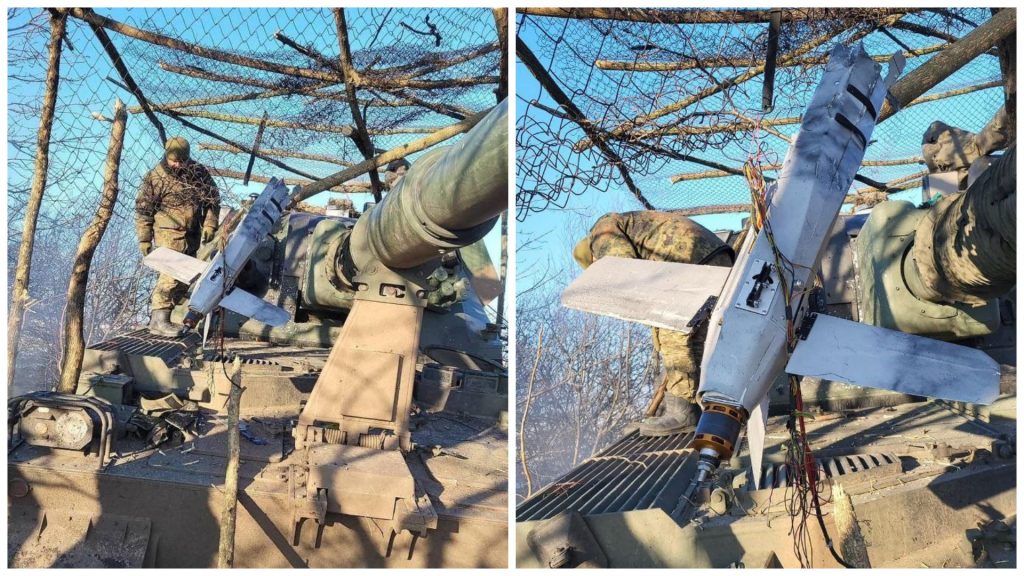
Although tremendously increased, Ukraine's scope of production is still behind Russian state-organized manufacturing. According to Maxim Sheremet, founder of DroneSpace company, Ukraine currently produces about 50,000 FPV drones each month, significantly less than Russia’s estimated 300,000. The disparity in production capacity is attributed to a lack of thousands of engineers needed for drone manufacturing.
Another huge problem for Ukrainian drones and defense forces in general is Russia's strong electronic warfare, including small “trench EW” systems. This problem was admitted by Ukraine’s Commander-in-Chief Valeriy Zaluzhnyi, who noted it among five priorities where Ukraine should achieve superiority over Russia to win the war.
Along with UAVs and sea drones, Ukrainian manufacturers started producing land drones capable of distant mining and transporting small equipment and autonomous turrets firing machine guns with remote control.
Drones save soldier’s life every day of the war. That is why, in the 2024 budget, Ukraine allocated a record sum for developing drone production and purchasing drones. The Russian military budget is still 2.5 higher than Ukraine's, indicating that competition for production capacity and upcoming battles will be difficult.
Read more:
- Here is a map of all Ukraine’s 2023 drone strikes on Russian targets
- Study shows drones the cheapest, most effective in battle against Russian invasion
- War of drones: can Ukraine keep its asymmetric advantage?
- Russia plans 68% increase in 2024 military spending, surpassing Ukraine’s defense budget 2.5 times
- Ukraine to launch mass production of jam-resistant drone
- Minister: Ukraine makes tens of thousands of drones per month
- Ukraine deploys 2,000 domestically manufactured drones to most critical fronts of war



